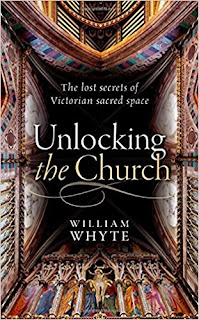Monday, December 4, 2017
Churches unlocked
William Whyte, Unlocking the Church: The lost secrets of Victorian sacred space
Published by Oxford University Press
Here’s the last of my Christmas book reviews: an illuminating study of 19th-century church buildings that’s also a good read…
William Whyte’s new book offers a revealing way of looking at Victorian churches, one that highlights neither the battle between architectural styles nor the distinction between ‘high’ and ‘low’ church. Whyte instead concentrates on the ways the Victorians understood and experienced church buildings, stressing in particular two key ideas – the church as a symbolic building that can be ‘read’ and the idea that church architecture can shape people’s emotions. Both of these themes are given a new emphasis in the 19th century and they cross theological boundaries: they are expressed by High churchmen and Evangelicals, by Catholics, and even by nonconformists.
These ideas are in sharp contrast to those of the Georgian period, in which churches lacked rich symbolic content. But, as Whyte shows, they predate the influence of the Cambridge Ecclesiologists and the Oxford Movement, which were in other ways so influential on the Victorian church. They go a long way to explain Victorian architectural preferences, and underpin changes in the way churches were lit, their seating arrangements, and such things as the use of flowers to decorate churches. And they influenced the way churches were used, not just in the increased number of church services, but also the way in which churchyards were reclaimed as sacred spaces, the development of church parades and processions, the movement to keep churches unlocked during the week, and even the design of buildings such as parsonages and schools.
The people behind all this are central to the story. Whyte dwells not only on clergymen and architects, but also on lay patrons and, importantly, antiquaries. These were the people who wrote about church architecture, who interpreted it for the public, and who regularly insisted on its symbolic content – not least in the thousands of church guidebooks that were written in the 19th century. We are the heirs of these people, not just because we still use and visit Victorian churches (and, of course, churches restored by the Victorians) but also because we inherit these notions of symbolism and of architecture that moves us. If we want to preserve Victorian churches or their fittings, it is often because they move us, or because they are powerfully symbolic.*
Unlocking the Church is a necessary corrective to the tendency to look at Victorian churches in purely architectural terms. If we cannot quite see Victorian buildings as the Victorians saw them, the book helps get much nearer that elusive ideal.
- - - - -
*Ironically, the fact that buildings have this power is even behind reorderings that attempt to do away with Victorian church fittings (if buildings did not have such a powerful effect, ‘modernizers’ would not take so much trouble to try to reorder them), as Whyte points out.

No comments:
Post a Comment